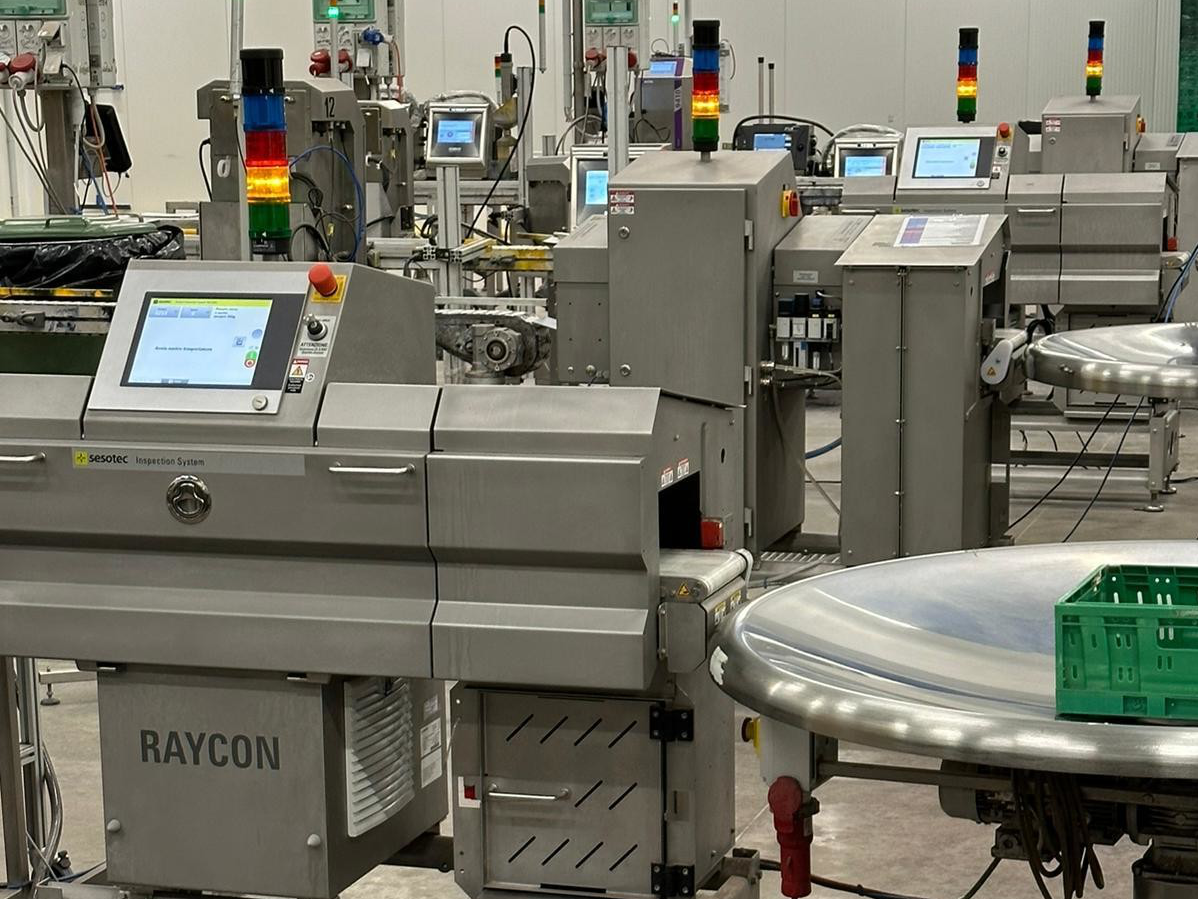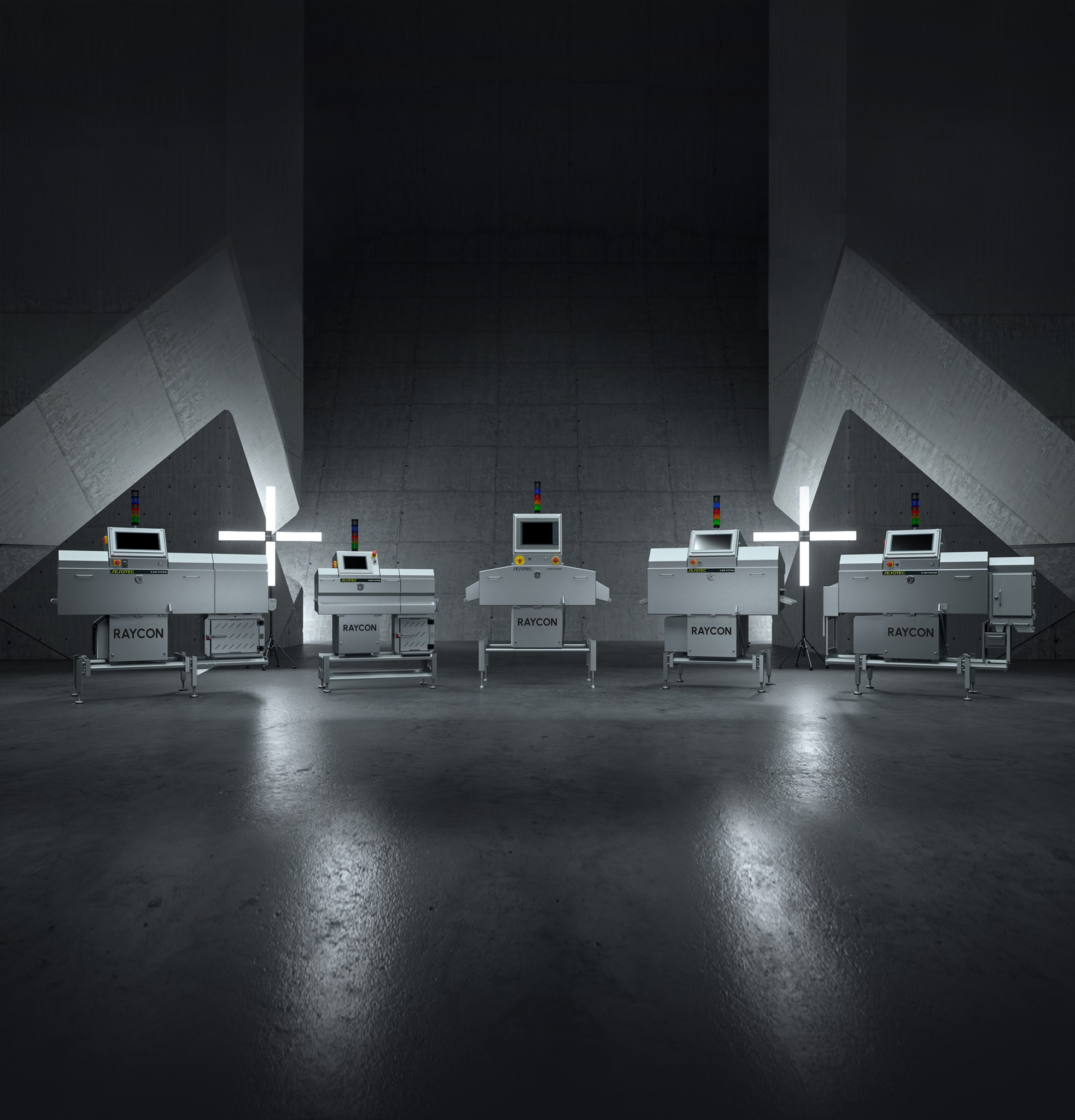In the food industry, product quality and consumer protection are paramount. Contaminations or defects in food can lead to serious health risks for consumers and result in reputational damage and legal repercussions for companies. This is where X-ray systems come into play—a dependable, non-invasive solution to ensure the safety and quality of food products.
How Does X-Ray Inspection Work in Food Production?
X-ray inspection systems scan products as they move uniformly through an X-ray beam on a conveyor belt. A detector unit installed above the conveyor converts the radiation into an electrical signal, which is transformed into a digital X-ray image using specialized software. This image is analyzed for foreign bodies and defects such as air bubbles, fractures, or deformations. Contaminated products are sorted out by integrated separation systems—quickly, precisely, and effectively.
What foreign bodies can be detected?
X-ray systems detect foreign bodies whose density significantly differs from that of the product. These include:
- Metals: Magnetic and non-magnetic stainless steels, aluminum, and other non-ferrous metals.
- Glass, ceramics, and stone: Common contaminants in food production.
- Plastics: Certain types like PVC or Teflon.
- Other defects: Bones, air bubbles, clumped or damaged products.
Particularly impressive is the ability to detect foreign bodies even in complex packaging such as aluminum foil or cans.
Advantages of X-Ray Technology
- Hygienic Design: Easy to clean and maintain, perfect for the food industry.
- Precise Detection: Reliably identifies foreign bodies as small as 0.3 mm.
- Standards Compliance: Systems meet common guidelines like BRC, IFS, and HACCP.
- Energy Efficiency: Low radiation energy makes it suitable for organic products (EU Directive 1999/2/EC).
- Flexibility: Simultaneous inspection of various products, such as through the integration of multiple lines.

X-ray Systems: Practical Applications
Whether it's packaged products like tubes and cans or unpackaged bulk goods, X-ray technology offers versatile applications. Modern devices can not only detect foreign bodies but also check for completeness, identify over- or underweight, and spot product defects. This ensures comprehensive quality control, especially in the final production phase (end-of-line).
X-ray Inspection Systems: Customized Solutions for Packaged and Unpackaged Products
The food industry demands exceptional precision and efficiency in quality control. Modern X-ray inspection systems are indispensable tools, tailored specifically for both packaged and unpackaged products. These systems provide effective solutions to detect contaminants, safeguard consumers, and optimize production processes.
X-ray Inspection Systems for Packaged Products
In the end-of-line inspection of packaged goods, X-ray inspection systems play a crucial role. These systems are designed to reliably detect foreign bodies such as glass, ceramics, stones, metals, and even plastics—even in complex packaging like aluminum foil or cans.
Features and Benefits
- Accurate Foreign Body Detection: Systems can detect not only metallic but also non-metallic contaminants.
- Check for Product Defects: In addition to foreign bodies, product defects such as air bubbles, fractures, over- or underweight are identified.
- Hygienic Design: Easy access and tool-free maintenance simplify cleaning and upkeep.
- Integrated Separation Systems: Contaminated products are automatically sorted out, increasing the efficiency of the production line.
- Compliance with Standards: The systems comply with guidelines such as BRC, IFS, and HACCP, ensuring the highest safety and quality standards.
X-ray Inspection Systems for Unpackaged Products
For unpackaged bulk goods like grains, powders, or chopped foods, X-ray technology offers specialized solutions designed for efficiency, safety, and ease of use. Products are evenly distributed over a conveyor belt and inspected for foreign bodies.
Features and Benefits:
- Highly Efficient Detection: In addition to metals, contaminants such as glass, ceramics, and stones are reliably identified.
- High Speed: With a belt speed of up to 1.4 m/s, large quantities – up to 13,500 kilograms per hour – can be examined in real-time.
- User-Friendly: A large touchscreen, intuitive user interface, and auto-learn function significantly simplify operation.
- Thoughtful Hygiene Concept: An open design and tool-free access allow for quick cleaning and maintenance.
- Safety for People and Products: An innovative radiation protection concept ensures safe operation in compliance with legal requirements.
Tailored Solutions for Every Need
Choosing between X-ray systems for packaged or unpackaged products depends on the specific needs of your production line. Both types offer flexible customization options to ensure seamless integration into existing processes. Enhanced by advanced analysis software and reliable service solutions, they represent a long-term investment in quality and safety.
Whether for packaged goods or bulk materials, X-ray inspection systems are essential for companies prioritizing quality assurance and consumer protection. They are not only at the forefront of technology but also crucial for regulatory compliance and safeguarding brand reputation.
Why Choose X-ray Inspection?
X-ray inspection not only safeguards consumers but also protects manufacturers from costly recalls and complaints. The systems' high speed and precision ensure that production lines can continue without interruption. Companies also benefit from extensive features such as remote maintenance, data transmission, and intuitive operation.
X-ray technology sets new standards in end-of-line inspection. It guarantees food safety and contributes to long-term brand reputation. With this innovative technology, manufacturers can ensure that only flawless products reach consumers—an invaluable advantage in a highly competitive market.

